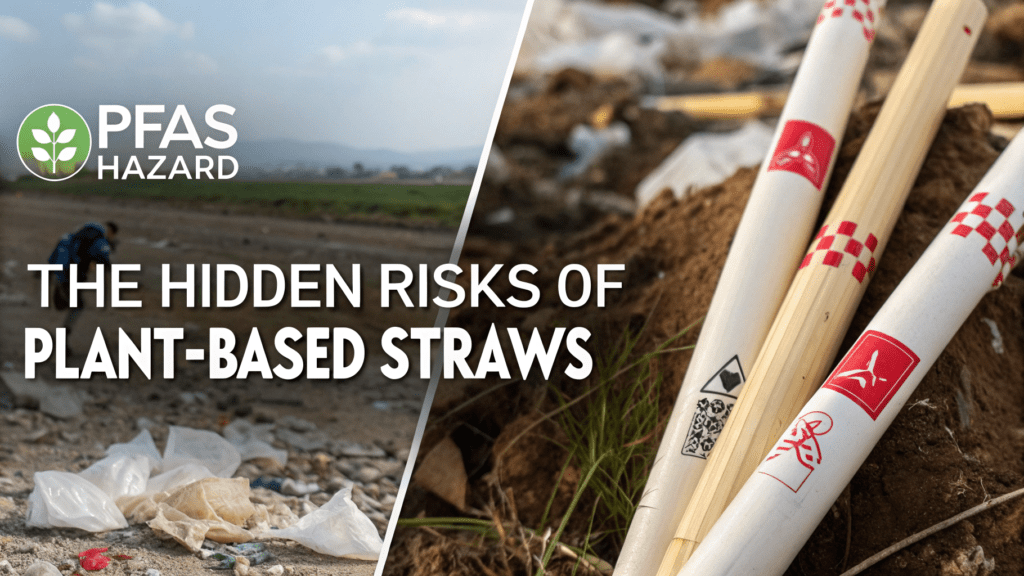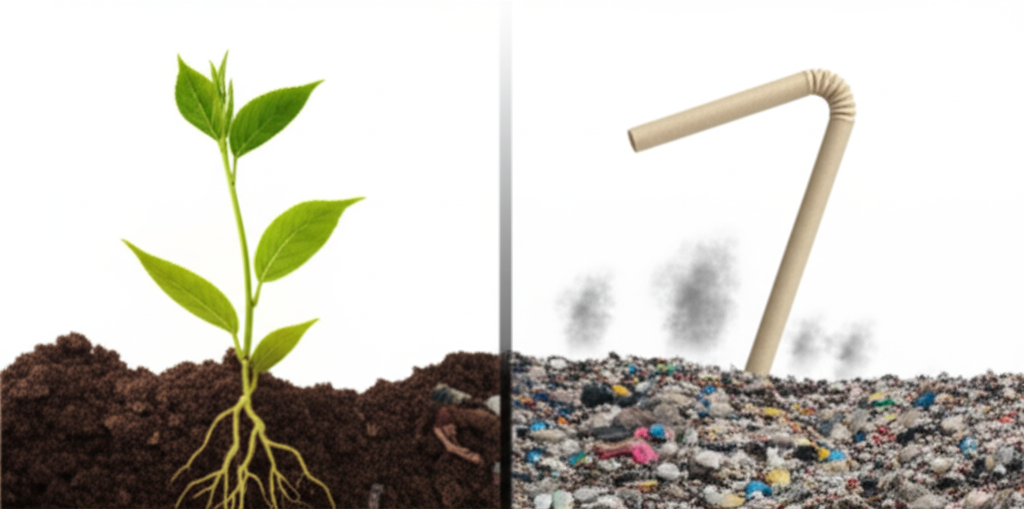A Critical Look for Procurement Managers, Operations Directors, and Sustainability Officers in Hospitality & Foodservice

The global shift towards perceived “sustainable” alternatives has propelled plant-based straws into the spotlight, driven by escalating consumer demand and tightening environmental regulations. For procurement managers, operations directors, sustainability officers, and supply chain executives in the hospitality and foodservice industries, the allure of these “eco-friendly” options often overshadows a complex reality. While initially championed as a simple solution to plastic pollution, plant-based straws introduce a myriad of hidden challenges and unforeseen costs. This deep dive uncovers the critical problems that demand a reevaluation of their role in your supply chain, redefining what true sustainability means for your enterprise.
The Pervasive Threat of “Forever Chemicals” in Plant-Based Straws
The promise of a greener future clashes with an alarming truth: many plant-based straws contain Per- and Polyfluoroalkyl Substances (PFAS), widely known as “forever chemicals.” These compounds are prized for their water-repellent properties, making them seemingly ideal for paper and bamboo straws. However, their persistence poses significant environmental and health risks that can profoundly impact your brand and bottom line.
Unmasking PFAS Contamination in Plant-Based Straws
Recent research casts a long shadow over the “green” credentials of these products. A seminal 2021 University of Florida study, published in *Chemosphere*, found detectable PFAS in 36 of 38 biodegradable straw brands tested, acquired directly from Amazon. Further reinforcing this concern, a comprehensive 2023 Belgian study in *Food Additives and Contaminants* reported PFAS in a staggering 90% of paper straw brands and 80% of bamboo straw brands examined. These findings indicate a systemic issue, not isolated incidents.
The health implications of PFAS exposure are well-documented and severe. The National Institutes of Health (NIH.gov) links PFAS to a range of adverse effects, including thyroid disease, liver damage, increased cholesterol levels, kidney cancer, and testicular cancer. While individual exposure from a single straw might seem negligible, these chemicals accumulate in the human body over time, contributing to a cumulative chemical load that is a growing concern for public health and, by extension, consumer confidence in products deemed “safe.”
Regulatory Scrutiny and Compliance Risks for Procurement
The persistent nature of PFAS chemicals means they do not readily degrade, posing long-term environmental and human health risks. Regulatory bodies globally are increasingly cracking down. For instance, PFOA, a common type of PFAS, has been globally banned since 2020 due to its severe environmental and health impacts. This evolving regulatory landscape mandates rigorous supply chain due diligence for any B2B entity sourcing plant-based alternatives.
Beyond direct compliance fines, the association with “forever chemicals” can inflict irreparable damage on corporate sustainability image and consumer trust. In an era of heightened environmental awareness and corporate accountability, a greenwashing scandal or public outcry over PFAS contamination can erode brand value, alienate environmentally conscious customers, and lead to significant market share losses. Procurement leaders must recognize that the hidden cost of PFAS extends far beyond the unit price of a straw.

Many plant-based straws contain harmful PFAS “forever chemicals,” posing significant brand and compliance risks for hospitality businesses.
The Illusion of Biodegradability: Why Plant-Based Straws Don’t Always Disappear
The term “plant-based” often conjures images of effortless decomposition back into nature. However, for many plant-based straws, particularly those made from Polylactic Acid (PLA), this biodegradability is largely an illusion without specific, often unavailable, conditions.
The Industrial Composting Conundrum & Compostable Straw Challenges
PLA straws, derived from fermented plant starches like corn or sugarcane, are indeed compostable – but only under very specific, high-temperature industrial composting conditions, typically requiring temperatures of 140°F (60°C) for several days, along with a controlled microbial environment. Without these precise settings, common in only a fraction of waste management facilities, PLA can persist.
If PLA straws enter a landfill without industrial composting, they can linger for 100 to 1,000 years, slowly releasing potent methane gas, a greenhouse gas significantly more damaging than CO2. The infrastructure gap for effective bioplastic disposal is vast: according to the Sustainable Packaging Coalition, only about 15% of composting facilities in the U.S. accept bioplastics. This means the vast majority of “compostable” straws end up in landfills, negating their intended environmental benefit. The French Agency for Food, Environmental and Occupational Health & Safety (ANSES) has explicitly stated that biobased products may not degrade effectively in home compost and could even release pollutants, further complicating proper disposal.
Regulatory Ambiguity and Waste Stream Contamination
The vague and often misleading labels like “biodegradable” can create significant confusion for operations teams and end-consumers alike, leading to incorrect waste disposal. When “compostable” PLA straws are mistakenly placed in traditional plastic recycling bins, they become a contaminant, compromising the entire recycling stream. PLA, chemically distinct from common petroleum-based plastics, cannot be recycled alongside them, hindering overall recycling efforts and increasing operational costs for waste management.
This challenge has led to direct policy responses. France, for instance, banned some disposable biobased straws under its Single-Use Plastics Directive (SUPD) law in 2021, precisely due to concerns about their incomplete degradation and potential to release pollutants, even if biobased. This regulatory precedent highlights the risk of relying on materials that do not perform as advertised in real-world waste streams.

Many “compostable” plant-based straws require specific industrial facilities, often ending up in landfills and contaminating recycling streams.
Operational Hurdles & Customer Dissatisfaction with Plant-Based Straws
Beyond environmental and regulatory concerns, plant-based straws often fall short on fundamental operational and customer experience metrics, creating tangible business problems for B2B enterprises in hospitality and foodservice.
Performance Deficiencies Impacting User Experience
Customer satisfaction is paramount. Unfortunately, plant-based straws frequently disappoint. Paper straws are notoriously prone to rapid degradation, becoming soggy and unusable, especially in hot or alcoholic beverages, leading to the dreaded “soggy sip.” This directly impacts the user experience and can reflect poorly on the beverage provider. PLA straws, while more durable initially, are often brittle, prone to breaking, and can create sharp, hazardous edges, posing a safety risk. Furthermore, many users report an unwelcome “papery taste” or a subtle alteration of beverage flavor, diminishing the quality of the drink itself.
Supply Chain and Cost Implications for B2B
The shift to plant-based straws also carries significant financial and logistical implications. They are generally more expensive to procure than traditional plastic straws. For example, a plant-based PLA straw can cost around $0.24 each, a substantial increase compared to approximately $0.052 for a traditional plastic straw. This disparity directly impacts profitability, especially for high-volume operations like QSRs or hotel chains.
Scaling the production of consistent, high-performing plant-based alternatives remains a challenge for manufacturers, leading to potential supply chain instability. For operations directors, managing diverse material types (e.g., paper, PLA, various emerging bio-alternatives) adds layers of logistical complexity to inventory, storage, and waste segregation protocols, increasing operational overheads and the risk of mismanagement.
Plant-based straws often disappoint customers with sogginess or breakage, increasing costs and complicating supply chain management for businesses.
The Unseen Environmental Footprint of “Green” Plant-Based Straws
While marketed for their environmental benefits, the full lifecycle of plant-based straws reveals an often-overlooked ecological footprint that extends beyond just their disposal, impacting the broader hospitality supply chain.
Resource-Intensive Production and Chemical Leaching
The production of PLA bioplastics is inherently tied to agriculture, consuming significant land and water for crops like corn or sugarcane. This raises critical questions about food security, land use changes, and water resource depletion, especially in regions facing water stress. Similarly, the manufacturing of paper straws contributes to deforestation and demands substantial energy and water consumption, along with the use of chemical additives for wet strength and binding.
Moreover, the materials themselves are not inert. A January 2024 study in *Food Packaging and Shelf Life* revealed that 19 chemicals, including known endocrine disruptors, migrated from paper straws into soda samples, highlighting potential health and environmental risks during the product’s use phase. This chemical migration undermines the “natural” and “safe” perception often associated with plant-based products.
Microplastic Formation and Ecosystem Impact
Even if a plant-based straw eventually degrades, the process can still lead to environmental harm. If not properly composted, “degradable” plant-based materials can break down into microplastics. Research by Niu et al. (2024) indicates that while PLA might release fewer microplastics than traditional plastic, the release of these pervasive particles remains a concern.
These microplastics, whether from conventional plastics or poorly degraded bio-materials, pose a significant threat to marine ecosystems. They are readily ingested by marine life, leading to bioaccumulation in the food chain, which can eventually impact human health. Furthermore, the degradation of PLA can increase environmental acidity, directly harming aquatic ecosystems and exacerbating existing environmental challenges.

Plant-based straws have a hidden environmental footprint, including resource-intensive production, chemical leaching, and microplastic formation.
Comparison Table: Evaluating Straw Alternatives for B2B
To make truly informed decisions, B2B leaders in hospitality and foodservice must weigh the operational, compliance, and financial implications of each straw alternative.
| 特徴 | B2B運用上の影響 | コンプライアンスノート | ROIポテンシャル |
|---|---|---|---|
| Traditional Plastic | Low cost, high durability, established supply chain | Increasing regulatory bans (e.g., EU Single-Use Plastics Directive) | Negative: High environmental cost, potential for future regulatory fines |
| PLA Plant-Based | Moderate cost, durability issues, requires specific disposal | “Compostable” claims often require industrial facilities (ASTM D6400) | Moderate: Perceived sustainability, but high disposal costs if infrastructure lacking |
| 紙 | Moderate cost, poor wet strength, inconsistent taste | Risk of PFAS contamination (90% of brands per Belgian study) | Low: Frequent customer complaints, high consumption due to sogginess |
| Reusable (Metal/Glass) | High initial cost, cleaning/storage logistics | High compliance for reusability, reduces waste | High: Long-term cost savings, strong brand sustainability image |
| Emerging Bio-alternatives | Variable performance, limited scalability, higher cost | Evolving standards; requires robust third-party certification (BPI, CMA) | High: Potential for true circularity, strong brand differentiation |
Evaluating straw alternatives requires weighing operational impact, compliance, and ROI, considering hidden costs and true sustainability.
Mini Case Study: The Restaurant Chain’s Sustainable Straw Pivot
A major quick-service restaurant (QSR) chain embarked on an ambitious journey to achieve 100% plastic-free operations by 2023, beginning with a system-wide transition to paper straws. The initial intention was to align with consumer expectations for sustainability and reduce plastic waste.
However, the pivot quickly encountered unforeseen challenges. Within three months of the transition, the chain experienced a significant 15% decrease in positive beverage reviews, with consumer feedback overwhelmingly citing “soggy straws” and an unwelcome alteration to drink taste. This directly impacted customer satisfaction and loyalty. Operationally, the situation worsened. Customers frequently needed multiple soggy straws per drink, leading to an unforeseen increase in procurement volume and inflated expenses. Furthermore, the complexities of managing waste for “compostable” PLA cups and paper straws, which often ended up in general waste due to lack of industrial composting access, inflated overall operational expenses by an additional 10%.
The chain was forced into a strategic re-evaluation, acknowledging the gap between sustainable intent and practical execution. They are now actively exploring certified PFAS-free options and investing heavily in comprehensive consumer education campaigns on proper disposal to mitigate ongoing reputational and operational damage. This highlights a crucial lesson: “green” claims must be backed by real-world performance and disposal infrastructure.
A QSR chain’s shift to paper straws led to decreased satisfaction and increased costs, highlighting the need for practical sustainable solutions.
Navigating the Future: Strategic Alternatives to Problematic Plant-Based Straws
The complexities of current plant-based straw options necessitate a proactive, strategic approach for B2B leaders in hospitality and foodservice. The future of sustainable packaging lies not just in what materials are used, but how they are sourced, certified, and managed across their entire lifecycle.
Prioritizing Truly Sustainable Sourcing and Certification
For procurement and sustainability officers, the imperative is clear: demand transparency and rigorous third-party certifications. Insist on explicit PFAS-free certifications from suppliers. Verify industrial compostability claims with reputable certifications such as those from the Biodegradable Products Institute (BPI) or TÜV Austria’s “OK Compost” labels, ensuring products genuinely break down in appropriate facilities. Partner with manufacturers who offer full lifecycle transparency and provide third-party verified environmental impact data. Staying ahead of evolving global regulations, such as China’s GB/T 41008-2021 standards for biodegradable straws implemented in June 2022, is crucial for maintaining market access and avoiding future compliance headaches.
Embracing Reduction and Reusable Solutions
True sustainability often begins with reduction. Businesses should proactively encourage customers to “skip the straw” when unnecessary or to bring their own reusable options. For in-house dining settings, explore scalable reusable straw programs using durable, easy-to-clean materials like stainless steel or glass, focusing on robust cleaning and sanitization protocols. While initial investment and logistical adjustments are required, reusable solutions offer significant long-term cost savings and bolster a strong brand sustainability image. Furthermore, strategic investment in research and development for next-generation bio-based materials with proven, verifiable biodegradability in diverse environments will be key to unlocking genuinely eco-friendly single-use options.
Future sustainability demands transparent sourcing, third-party certifications, reduction strategies, and exploring reusable or truly biodegradable alternatives.
Conclusion: Rethinking “Green” for True Sustainability
The journey toward sustainable packaging is undeniably complex, and the narrative around plant-based straws, despite their well-intentioned origins, reveals significant challenges. For B2B decision-makers in procurement, operations, and supply chain within hospitality and foodservice, understanding the pervasive issues of PFAS contamination, the misleading nature of biodegradability claims, and the tangible operational impacts is paramount. This knowledge is not merely academic; it is critical to avoiding greenwashing, ensuring regulatory compliance, and safeguarding brand reputation.
True environmental responsibility and a future-proof supply chain demand materials that are genuinely eco-friendly, operationally efficient, and unequivocally safe. The time for a superficial embrace of “green” labels is over. It’s time for materials that deliver on their promise.
True sustainability requires moving beyond superficial “green” claims to genuinely eco-friendly, efficient, and safe supply chain solutions.
よくある質問(FAQ)
Do plant-based straws contain ‘forever chemicals’ (PFAS)?
Yes, recent studies, including a 2023 Belgian study, found PFAS in up to 90% of paper and 80% of bamboo straw brands, posing environmental and health risks for hospitality operations.
Are ‘compostable’ plant-based straws truly biodegradable in all settings?
No, most plant-based straws like PLA require specific high-temperature industrial composting facilities to degrade, which are only available in about 15% of U.S. facilities, often ending up in landfills.
How do plant-based straws impact customer satisfaction in foodservice?
Paper straws often become soggy quickly, and PLA straws can be brittle or impart a ‘papery taste,’ leading to decreased beverage reviews and customer dissatisfaction in QSRs and cafes.
What are the hidden costs of switching to plant-based straws for B2B buyers?
Beyond higher unit costs (e.g., $0.24 for PLA vs. $0.052 for plastic), hidden costs include increased procurement due to sogginess, waste management complexities, and potential brand damage from greenwashing claims.
What sustainable alternatives should hospitality businesses consider instead of problematic plant-based straws?
Prioritize PFAS-free, third-party certified options, embrace reduction strategies like ‘skip the straw,’ and explore scalable reusable straw programs for in-house dining to ensure true sustainability.






